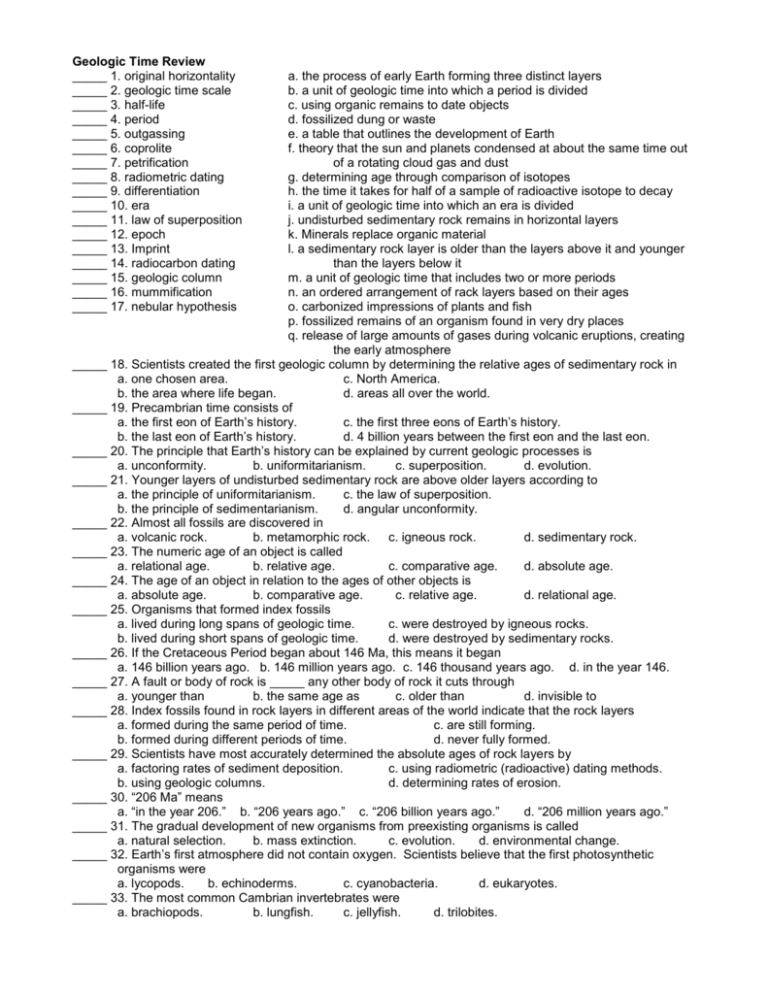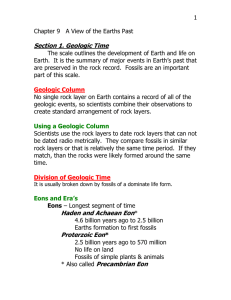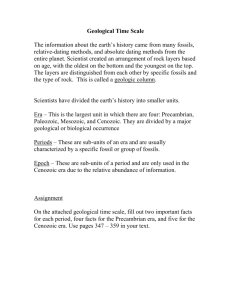Review Quizzes
advertisement

Geologic Time Review _____ 1. original horizontality _____ 2. geologic time scale _____ 3. half-life _____ 4. period _____ 5. outgassing _____ 6. coprolite _____ 7. petrification _____ 8. radiometric dating _____ 9. differentiation _____ 10. era _____ 11. law of superposition _____ 12. epoch _____ 13. Imprint _____ 14. radiocarbon dating _____ 15. geologic column _____ 16. mummification _____ 17. nebular hypothesis The a. the process of early Earth forming three distinct layers b. a unit of geologic time into which a period is divided c. using organic remains to date objects d. fossilized dung or waste e. a table that outlines the development of Earth f. theory that the sun and planets condensed at about the same time out of a rotating cloud gas and dust g. determining age through comparison of isotopes h. the time it takes for half of a sample of radioactive isotope to decay i. a unit of geologic time into which an era is divided j. undisturbed sedimentary rock remains in horizontal layers k. Minerals replace organic material l. a sedimentary rock layer is older than the layers above it and younger than the layers below it m. a unit of geologic time that includes two or more periods n. an ordered arrangement of rack layers based on their ages o. carbonized impressions of plants and fish p. fossilized remains of an organism found in very dry places q. release of large amounts of gases during volcanic eruptions, creating the early atmosphere _____ 18. Scientists created the first geologic column by determining the relative ages of sedimentary rock in a. one chosen area. c. North America. b. the area where life began. d. areas all over the world. _____ 19. Precambrian time consists of a. the first eon of Earth’s history. c. the first three eons of Earth’s history. b. the last eon of Earth’s history. d. 4 billion years between the first eon and the last eon. _____ 20. The principle that Earth’s history can be explained by current geologic processes is a. unconformity. b. uniformitarianism. c. superposition. d. evolution. _____ 21. Younger layers of undisturbed sedimentary rock are above older layers according to a. the principle of uniformitarianism. c. the law of superposition. b. the principle of sedimentarianism. d. angular unconformity. _____ 22. Almost all fossils are discovered in a. volcanic rock. b. metamorphic rock. c. igneous rock. d. sedimentary rock. _____ 23. The numeric age of an object is called a. relational age. b. relative age. c. comparative age. d. absolute age. _____ 24. The age of an object in relation to the ages of other objects is a. absolute age. b. comparative age. c. relative age. d. relational age. _____ 25. Organisms that formed index fossils a. lived during long spans of geologic time. c. were destroyed by igneous rocks. b. lived during short spans of geologic time. d. were destroyed by sedimentary rocks. _____ 26. If the Cretaceous Period began about 146 Ma, this means it began a. 146 billion years ago. b. 146 million years ago. c. 146 thousand years ago. d. in the year 146. _____ 27. A fault or body of rock is _____ any other body of rock it cuts through a. younger than b. the same age as c. older than d. invisible to _____ 28. Index fossils found in rock layers in different areas of the world indicate that the rock layers a. formed during the same period of time. c. are still forming. b. formed during different periods of time. d. never fully formed. _____ 29. Scientists have most accurately determined the absolute ages of rock layers by a. factoring rates of sediment deposition. c. using radiometric (radioactive) dating methods. b. using geologic columns. d. determining rates of erosion. _____ 30. “206 Ma” means a. “in the year 206.” b. “206 years ago.” c. “206 billion years ago.” d. “206 million years ago.” _____ 31. The gradual development of new organisms from preexisting organisms is called a. natural selection. b. mass extinction. c. evolution. d. environmental change. _____ 32. Earth’s first atmosphere did not contain oxygen. Scientists believe that the first photosynthetic organisms were a. lycopods. b. echinoderms. c. cyanobacteria. d. eukaryotes. _____ 33. The most common Cambrian invertebrates were a. brachiopods. b. lungfish. c. jellyfish. d. trilobites. _____ 34. The early oceans became salty when a. dissolved solids were carried from land into the oceans. b. salt dropped from the atmosphere into the oceans. c. sea creatures left salty deposits in their remains. d. the heavy atmosphere did not allow salt particles to dissipate. _____ 35. Water (H2O) for Earth’s oceans appears to have come from a. the bonding of hydrogen (H2) and oxygen (O2) during the Precambrian. b. the combustion of methane (CH4) during the Precambrian. c. outgassing and condensation of water (H2O) vapor from volcanoes during the Precambrian. d. upward seepage of H2O through porous igneous rock during the Precambrian. _____ 36. Which of the following accurately characterizes Precambrian rock? a. It has been severely damaged. c. It has clearly identifiable layers. b. It has many fossils. d. It contains much limestone. _____ 37. Dividing Precambrian time into smaller time units is difficult because a. it was a very short period. c. Earth went through few changes during this time. b. Precambrian fossils show a wide variety of life forms. d. few fossils exist in early Precambrian rocks. _____ 38. The division of geologic time that began with the last ice age and includes the present is called the a. Cretaceous Period. b. Tertiary Period. c. Quaternary Period. d. Cenozoic Era. _____ 39. Which animals do scientists believe could have been hunted by humans, based on evidence such as stone spear points found embedded in the animals’ bones? a. Dinosaurs b. Mammoths c. Armored fishes d. Trilobites _____ 40. Almost all fossils are discovered in a. igneous rock. b. metamorphic rock. c. sedimentary rock. d. organic materials. _____ 41. The division of geologic time that makes up about 88% of earth’s history is called a. the Paleozoic Era. b. the Cambrian Period. c. Precambrian time. d. the Permian Period. _____ 42. The early hydrogen and helium in Earth’s atmosphere were lost due to a. the intense gravitational pull of Jupiter. c. the rapid rotation of early Earth. b. Earth’s relatively weak gravitational field. d. the radioactive decay of hydrogen and helium. _____ 43. The Cenozoic Era is known as the a. Age of Reptiles. b. Age of Fishes. c. Age of Evolution. d. Age of Mammals. _____ 44. The mass extinction at the end of the Permian Period led to a. fewer resources during the Mesozoic Era. b. abundant new life forms in the Mesozoic and Cenozoic eras. c. delayed evolution of new species in the Cenozoic Era. d. little environmental change in the Mesozoic Era. _____ 45. What caused the differentiation of materials within early Earth? a. high density material sank; low density material sank b. high density material rose; low density material rose c. high density material sank; low density material rose d. high density material rose; low density material sank _____ 46. What is inferred to be the main source of the free oxygen that first entered Earth’s atmosphere? a. Meteorite impacts releasing oxygen. b. Oxygen producing organisms c. Melting of glacial ice into hydrogen and oxygen d. Radioactive decay of rocks containing oxygen _____ 47. Water vapor in the atmosphere of early earth collected and condensed to form rain, which collected on Earth’s surface, creating the first a. lakes. b. rivers. c. streams. d. oceans. _____ 48. Which of the following make it possible for Earth to support life? a. oxygen, land, water b. temperature, wind, water c. water, temperature, soil d. water, oxygen, temperature _____ 49. mass extinction a. sedimentary rock layers are younger than layers below _____ 50. unconformity b. current geologic processes are the same as those that were at work in _____ 51. trace fossil the past _____ 52. uniformitarianism c. an episode during which an enormous number of species dies _____ 53. index fossil d. a theory that a meteorite cause the extinction of dinosaurs _____ 54. impact hypothesis e. a break in the geologic record _____ 55. law of superposition f. a fossil that is used to date rocks g. a fossilized mark formed by the movement of an animal








